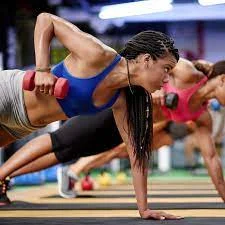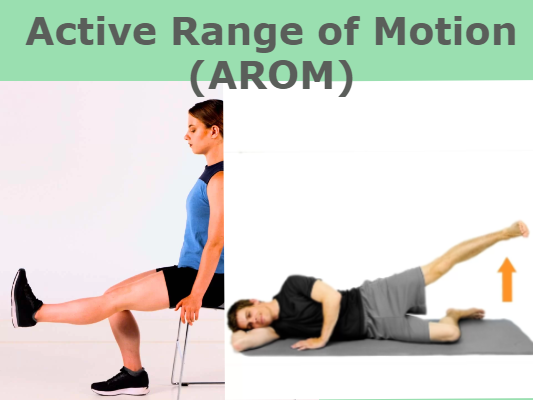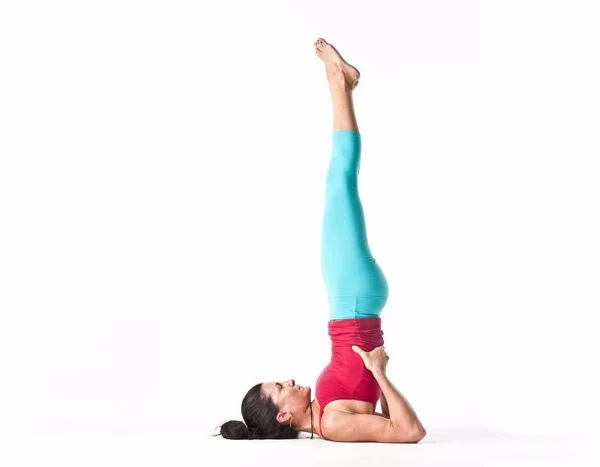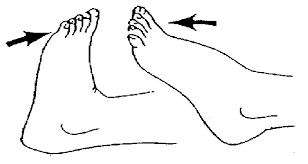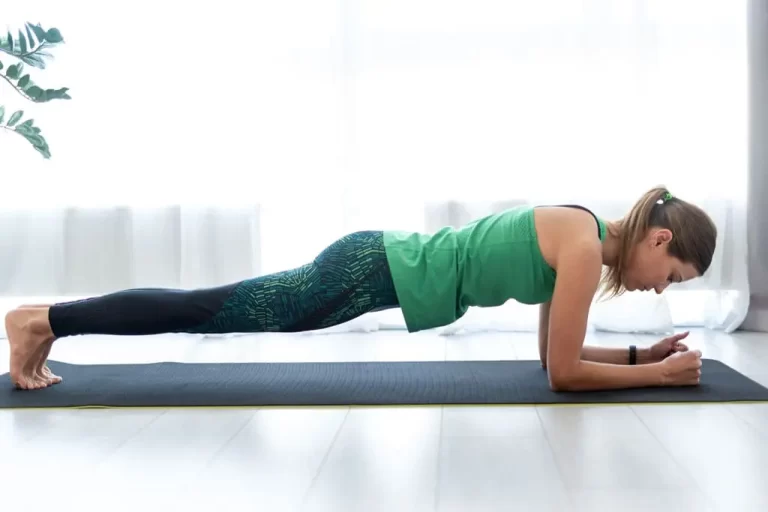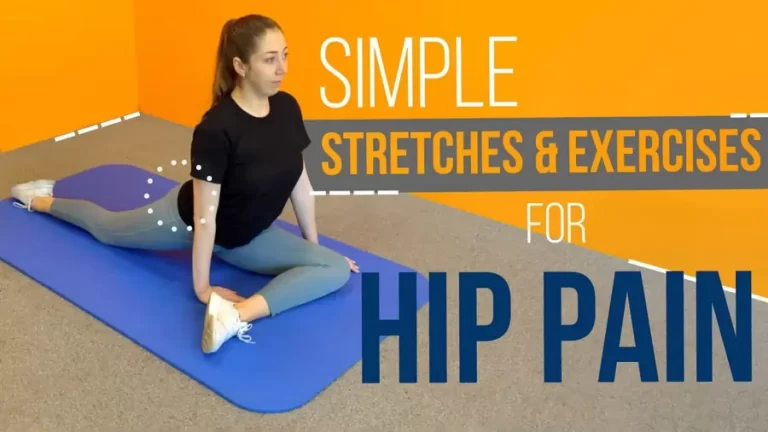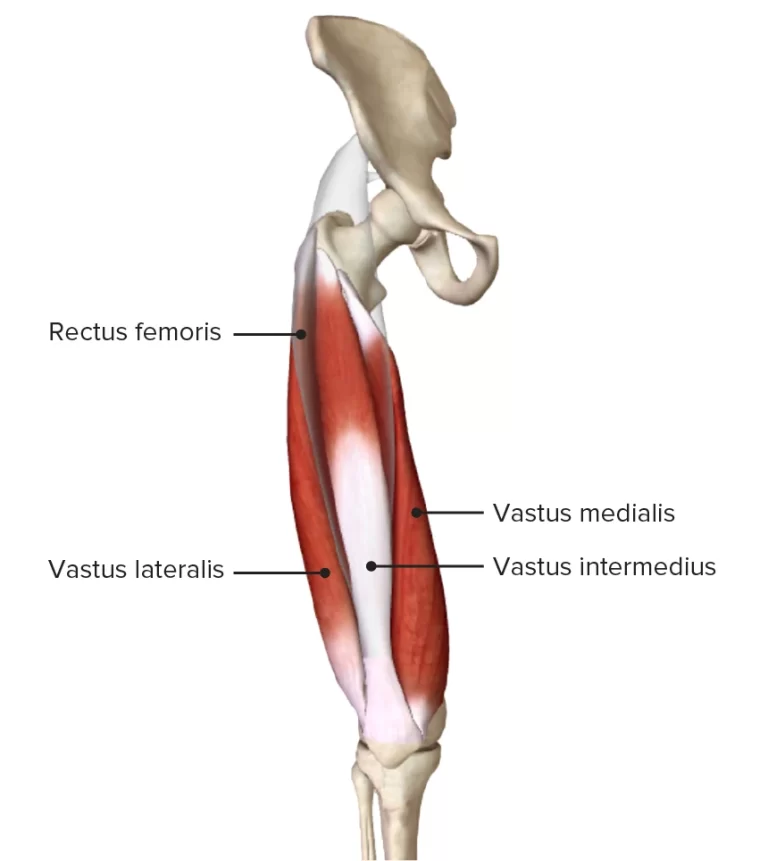Compound Exercises
What is a Compound Exercise?
Compound exercises are multi-joint movements that engage multiple muscle groups simultaneously, making them highly effective for building strength, improving coordination, and enhancing overall fitness.
Unlike isolation exercises that target a single muscle, compound exercises, such as squats, deadlifts, and bench presses, work several muscles at once, leading to better functional strength and more efficient workouts.
A strong foundation of strength throughout the body benefits bodybuilders, athletes, and even casual lifters. Lifting heavier weights, especially in complex exercises, will eventually lead to increased muscle mass, improved performance, and an improved quality of life. Although isolation exercises are useful, they don’t exert the same demands on one’s ability to balance and coordinate, bear weight, activate several muscle groups, or train the body in a broad “functional” manner as compound exercises.
Even though there are many great compound lifts, a strength and hypertrophy training program should emphasize some exercises over others. These are more complex workouts that use a variety of joints and muscles in a broad range of motion. Rather than recommending what you believe to be the best compound lifts to engage the specific muscle groups efficiently. If you want to acquire absolute strength, you can do the majority of these massive difficult exercises for one rep max without losing any strength.
This is one way that they are different from other smaller compound lifts. Your fundamental lifts should be the main focus of your training, with the weaker compound and accessory workouts utilized as a complement. Last but not least, these are your main complicated lifts, therefore you’ll likely just be using a barbell and plates.
Lifting heavier items is possible when you use a barbell. Dumbbells and machines work best for smaller compound exercises and isolation exercises, except beginners, who will probably benefit from dumbbells the most, and intermediate to advanced lifters who use machine and dumbbell compound lifts for muscle building or any other purpose specific to their training targets.
How should intricate exercise regimens be included in your daily schedule?
No matter how often you work out, your training regimen should include compound motions. Compound motions are quite versatile and easy to include in everyday activities. They don’t always need to be loaded, either. Exercises like the barbell back squat are challenging, especially when performed bodyweight. This enables you to modify your difficult exercises’ muscle focus, load, and intensity every time you work out. Compound movements offer a multitude of setup choices, making them extremely user-friendly.
Before performing any isolation exercises, concentrate on a large compound action, such as a squat or deadlift. This will ensure that you are concentrating on your most taxing exercise when your energy is at its highest. Depending on the severity of the exercise, Sung suggests three to five sets of five to twelve repetitions for beginners; if you’re using heavier weights, lower the rep count.
Should an individual only do compound exercises?
Even while hypertrophy, strength, fat loss, and endurance are the most important and desired attributes for most people, a training routine that just consists of compound lifts is usually not the best option for people who want to achieve a variety of fitness goals. So, isolation exercises have a purpose.
Since larger muscle groups are primarily responsible for the general movement patterning, more complicated motions could not adequately target specific muscle groups. It might be challenging to address particular deficits and muscle imbalances when complex lifts always put the stars in the spotlight. You can be quad-dominant during back squats and hamstring-dominant during deadlifts, so your glutes must work.
Furthermore, it’s possible that during complex lifts, some muscles exhaust themselves before others. Your legs may tire out before your lower back muscles do. To keep your lower back from tiring out before your legs and glutes in this situation, isolate it and strengthen it with hyperextensions. You may also need to do more isolated leg workouts, such as leg presses, to target your quadriceps. Assistance lifts are also available, although these should not be mistaken with more isolated compound motions; more on this later. Furthermore, you could find that some muscles need extra attention because the complex lifts aren’t working them through their full range of motion, which is advantageous for hypertrophy.
You may find that bent-over rows are not enough for your biceps, and that bench press and overhead press are not enough for your triceps and side/rear delts. For these tiny muscle groups, isolation workouts are essential for both muscular growth and aesthetic appeal. Even while you may have powerful shoulders by simply completing the overhead press, your side delts will stay undeveloped since the exercise primarily targets your upper chest and anterior deltoid, not your broad, popping shoulders.
Another significant advantage of isolation workouts is their capacity to activate certain muscles without adversely influencing other muscles that need to rest. You may avoid overusing or underusing specific muscle groups by performing the solo exercise. It will also help you reach the appropriate volume for each muscle group. Finally, isolation workouts are essential for the recovery of injured individuals.
Compound exercises
Barbell back squat

You can get a lot of strength and muscle growth in your three primary muscle groups-hamstrings, glutes, and quadriceps by performing barbell back squats. Barbell back squats enhance body awareness and coordination, lower back and core strength, and injury resilience by fortifying the joints, ligaments, and tendons that surround your knees and hips.
Both have advantages and disadvantages, including the low bar. You can generally lift bigger weights in a back squat because of the greater center of gravity, and the high bar allows you to After a deep squat, stand with your feet hip-width apart.
How to conduct: For intermediate and experienced exercisers, begin with a barbell that is either empty or loaded. Bodyweight squats should be moved to a heavier weight as the exercise becomes more comfortable.
In the muscles closest to your neck and upper back, your trapezius, place the bar as you approach the rack.
Take a step or two backward. That’s one rep.
Reps and sets: three eight-to-ten-rep sets.
Pullover
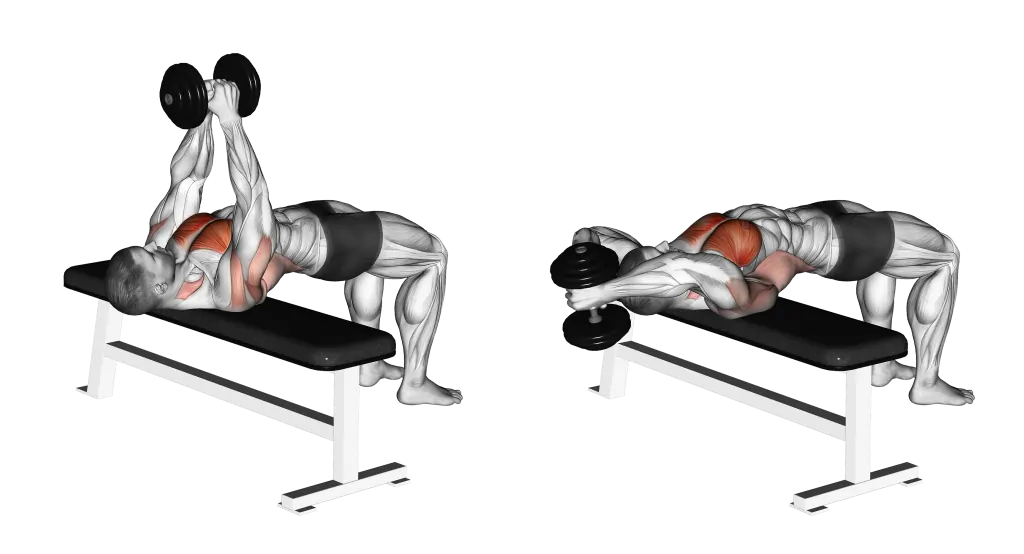
How to conduct: Using both hands, firmly grasp the dumbbell’s ends. It could seem safer to hold a larger dumbbell vertically with both hands wrapped around one end.
Lift the dumbbell over your head and place it gently on the ground. The enormous latissimus dorsi muscles are the main target of this vertical pulling exercise. Save this exercise for a great dumbbell session since it may be difficult to recognize dumbbell vertical pulls.
Dumbbell Deadlift
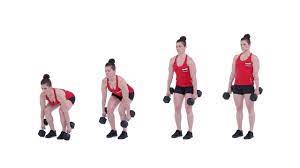
Equipment required: To boost effort, a barbell option can be supplemented with weights.
How to conduct: Place the barbell so that your toes are beneath it on the floor, keeping your feet hip-width apart. To get back up, keep a strong core and push through your heels. Make sure your glutes are tight as you get closer to the top of the squat. Keep your spine straight and avoid bending it.
Hold onto the bar with both hands. On the bar, place your hands just a little wider than your thighs.
Make sure your heels are firmly on the floor and your knees are relaxed when you stand up. Raise yourself till the bar almost reaches your hips. Finish by putting your glutes in a raised position at the top.
Take a minimum of 30 to 60-second break and repeat exercises 10 to 12 times in between sets. Complete three sets of tasks.
Reverse lunge to balance with bicep curl
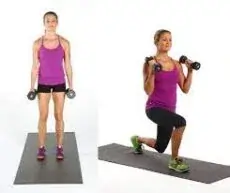
Required equipment: dumbbells
Hold the dumbbells in each hand. Flex your arms, and hands facing your body.
To regain your equilibrium, stride forward with your right foot and plant your left foot firmly on the ground. Raise your right foot off the ground while maintaining a strong planted left foot for balance.
Once the left side is complete, take a 60-90 second rest. Complete two or three sets.
Squat
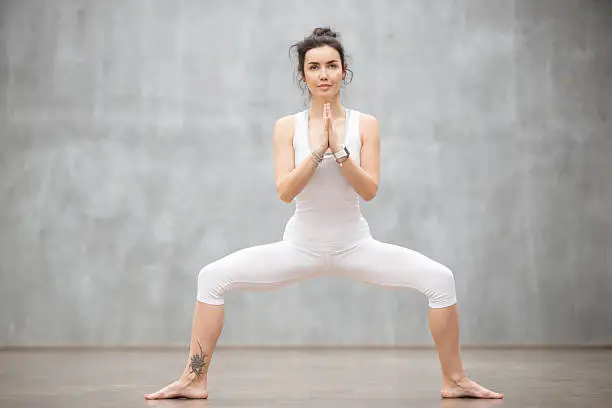
Required equipment: not one
How to conduct: According to Toes, you should begin with your feet somewhat wider than hip-width apart.
Push through your heels to return to your starting position while keeping your chest up and your core firm. At the top, clench your glutes.
Perform ten to fifteen reps. Complete three sets of tasks.
Front lunge with twist
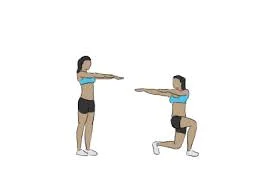
Equipment needed: none
target muscles: abs, glutes, hamstrings, and hips
How to conduct: Assume a high stance, with your feet shoulder-width apart and your arms out in front of you. Make a diving motion with your arms while leaning your right foot forward. Your knee shouldn’t go past your toes, and your front leg should be at a 90-degree angle. Additionally, your back leg will be inclined by ninety degrees.
Take a deep breath, thrust forward, turn your upper body to the right, and return to the center. Complete three sets of tasks
Dumbbell shoulder press on an exercise ball
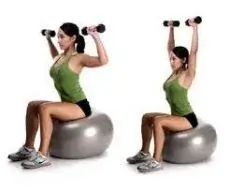
Workout balls, dumbbells, and abs are essential.
How to conduct: Using an exercise ball, take a seat and start to squeeze your abdominal muscles.
Make sure the dumbbells are 90 degrees away from your body.
Reposition your arms at a 90-degree angle and gradually elevate your elbow to shoulder height. Avoid lowering oneself below this posture as this may cause soreness in the shoulder joints.
Perform 12 to 15 reps. Complete three sets of tasks.
Rotating high plank T-spine
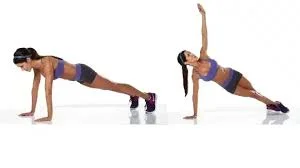
Required equipment: not one
muscle worked: abs and shoulders
How to conduct: To maintain a tight core, begin by putting your arms beneath your shoulders. When doing this exercise, maintain a hip-width distance between your legs.
As you tense your thighs and glutes, maintain a firm grip with your right palm on the ground.
Lift and press your left arm toward the ceiling while keeping your hips and shoulders oriented to the left. Finish the three sets of assignments.
Dumbbell press squat

How to conduct: Raise your arms to shoulder height, bend at the elbows, keep the weights near your ears, and spread your legs a little wider than hip-width apart.
Flex your knees while maintaining the position of your toe and heel to make them feel like a chair.
Stepping Lunge
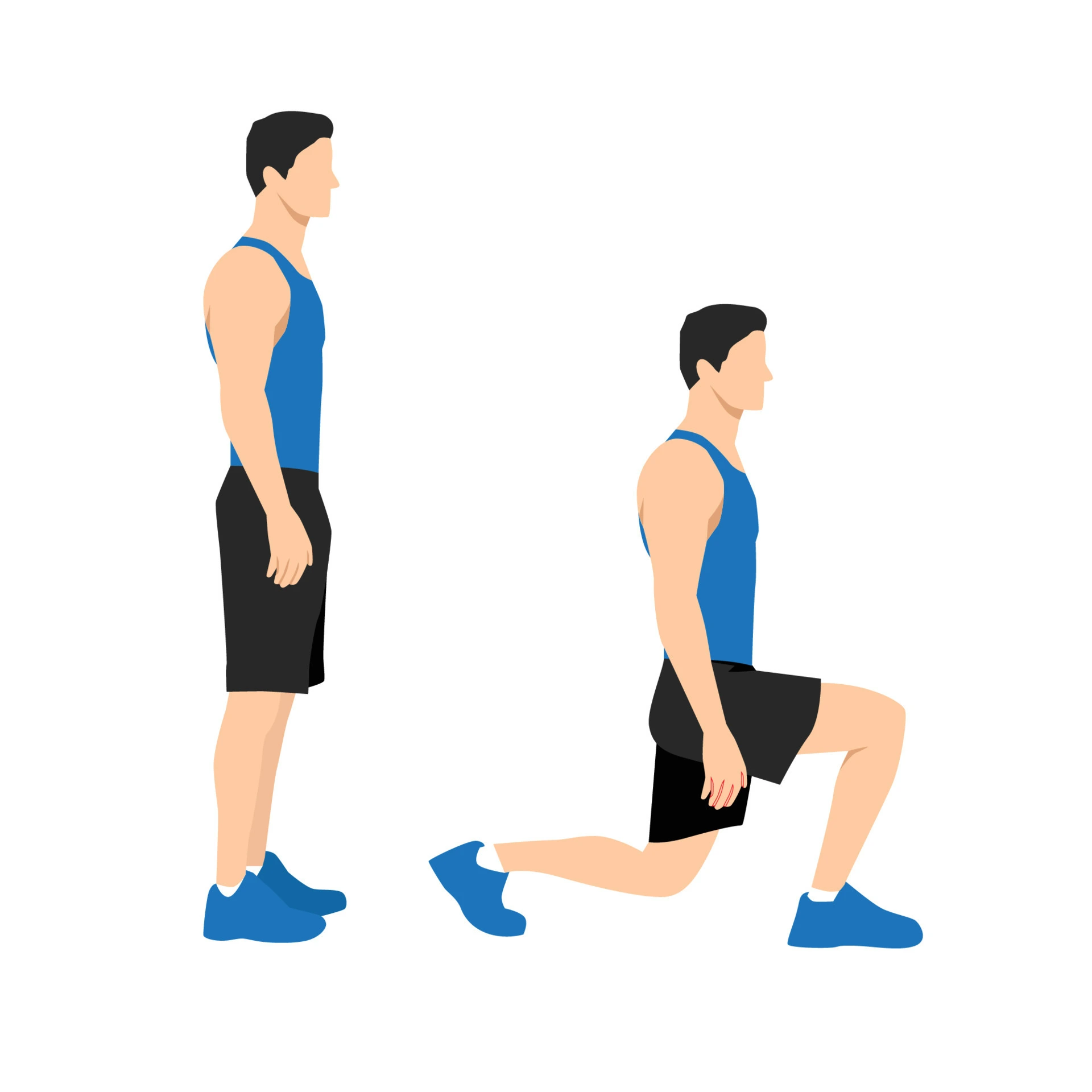
How to conduct: To maintain your erect posture and feet together, place ten-pound dumbbells at your sides. Beginners may practice walking lunges with just their body weight.
Step forward with your left leg while keeping both knees bent at a 90-degree angle. Drop your hips to the ground. It is ideal to have your front knee just above your ankle and your back knee pointed toward the ground but not contacting it. As you take a firm stride into an opposite-side lunge, pull your right leg forward with your right foot and press your left heel into the ground. That’s one rep.
lateral lunge With Bicep Curl
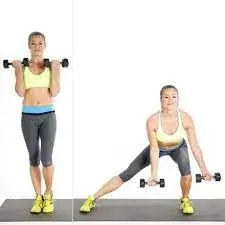
How to conduct: With your hands facing inward and your feet together, start standing. Maintain a dumbbell in front of your shoulders.
Point the toes and heel of your left foot forward as you sidestep. Holding dumbbells, stretch your left leg to the floor on both sides. Your back should stay flat, and your abs should continue to be firm.
Curl the dumbbells up to your shoulders, plant your left foot close to your right, then push off your left foot to stand back up. That’s one rep.
Barbell deadlift
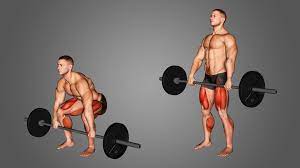
The deadlift is the most effective compound exercise you can do because it involves lifting the largest weight. That should be your strongest lift without a doubt.
One of our favorite barbell exercises, the deadlift, can help build stronger, larger muscles in both the upper and lower body. The quadriceps, glutes, hamstrings, and back are the primary muscles used, even though the entire posterior chain is covered. Naturally, grip strength and bone strength are developed as a result of having to hold onto the barbell.
Deadlifts, like squats, will enhance anabolic hormones. Additionally, deadlifts boost neurological strength, which is beneficial for harder upper and lower body exercises like barbell bench presses and squats. Your deadlift will get better with each pull, leading to stronger lifts all around. It is the strongest available booster.
You should look into alternatives to deadlifting if you are unable to perform them for any reason (lower back pain during deadlifting is typical; this is a high-risk, high-reward sort of workout).
Steps to Take: If your shins do not come into touch with the bar, they should.
Stretch your back from the waist after placing your buttocks on the bars on either side of your legs.
Make an overhand hold with both hands.
Remember to keep your hips and shoulders aligned. Put pressure on your shoulder blades to release tension from the bar and straighten your spine. As the weight is increased, keep your grip on the bar tight. Tighten your glutes such that your knees, hips, and shoulders are stacked on top of each other.
Repetition and Sets: Start with six to eight repetitions in three to six sets.
Barbell benchpress
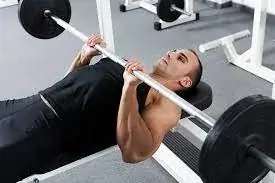
This is the most effective upper-body workout and the best compound lift for the chest.
Your chest will get stronger and more muscular if you press horizontally, as in the barbell bench press. Given that the chest is one of the strongest muscular regions in the body, this is unquestionably the best lift you can get for the money.
You will be able to shift your chest in different ways as you push your arms straight and then drop them down. Your posture and back strength will increase, your chest will get stronger and longer, and muscle growth will be encouraged. The bench press engages multiple muscle groups in addition to its primary one. Your quadriceps, lats, and anterior deltoids will all get stronger as a result. It also strengthens your core. The amount of stimulus your muscles experience during a bench press is also influenced by your grip.
How to do bench press: Sitting on the bench, make sure your feet are level with the floor. Pull your belly button back toward your spine to keep your glutes and core strong. To begin, set a barbell or dumbbell directly above your shoulders. Breathe deeply and keep your forearms parallel to the floor by bending your elbows as you lower yourself.
Exhale and push yourself up.
Sets & reps: Begin with three sets of eight to twelve reps.
Dumbbell bench press
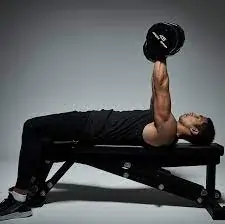
How to conduct: Return to the bench and press each dumbbell against your thighs with one hand.
Hold the dumbbells shoulder-width apart over your chest, keeping your forearms and upper arms at a 90-degree angle. The hands should face forward.
Exhale as you bring the dumbbells up to arm’s length. Please wait a moment.
That’s one rep. Do ten repetitions twice a day.
Dumbbell military press
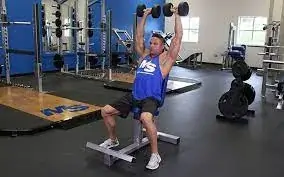
Strength and powerlifters employ this last Big Four compound workout. This additional workout allows you to perform heavy weightlifting at your one-rep maximum.
The military push is an intense vertical pressing exercise that tones your shoulders. It’s one of the most challenging exercises you’ll ever do, and it includes the finest compound raise for the arms.
It tones your biceps, lats, upper chest, and triceps in addition to building shoulder strength and mass. It also works wonders for strengthening the glutes and abdomen because when pushing hard pressure past the head from a standing position, these muscles must work extremely hard to maintain stability.
The military press should only be able to function when people are seated.
This is a crucial workout for athletes since it generates a lot of early power and strength. You’ll be able to exert pressure without having to accelerate first. The military press can be thought of as a reverse deadlift. It exercises the entire body. Additionally, the military press works every muscle that the deadlift fails to reach. The military press, along with the barbell squat, deadlift, and bench press, is one of the hardest exercises for building muscle and strength. The four exercises listed above are sufficient for powerlifters, but extra compound workouts are needed for individuals who want to address hypertrophy and strength training more thoroughly.
How to conduct: After consuming your meal on an elevated bench, raise some dumbbells. Verify that the back of the bench is 90 degrees angled.
Once seated, place a dumbbell on each leg. Try to keep your back and shoulders as straight as possible.
Dumbbells should be raised to shoulder height after being lifted off your thighs. Raising each thigh independently will help you handle hefty weights. Lifting a hefty dumbbell with just your arm could cause an injury. If that is how you want to execute a dumbbell press, you can also do it with your hands facing your body.
Dumbbells should be pressed above the head until the arms reach their maximum length. After a few seconds of holding the dumbbells above your head, bring them down to shoulder height.
Execute the required quantity of iterations. Do one set of eight to ten repetitions if you’re just getting started. After eating on a raised bench, pull up some dumbbells. Verify that the back of the bench is 90 degrees angled.
How to conduct: Pick up some dumbbells after eating on an elevated bench. Confirm that the bench’s back is at a 90-degree angle.
Once seated, place a dumbbell on each leg. As you sit, make sure your lower back is firmly placed against the back of the bench. Try an effort to keep a straight back and shoulders.
Dumbbells should be raised to shoulder height after being lifted off your thighs. Raise each thigh separately to aid in the carrying of large weights. Lifting a hefty dumbbell with just your arm could cause an injury. If that is how you want to execute a dumbbell press, you can also do it with your hands facing your body. Be sure the ground is at the same height as your forearms.
Pressing dumbbells above the head will cause the arms to fully expand. After a few seconds of holding the dumbbells above your head, lower them to shoulder height.
Execute the required quantity of iterations.
Pull-up

Pull-ups are essential for anyone who works a full-time job, is a bodybuilder, powerlifter, weightlifter, cross-fitter, or does anything else. Pull-ups are fundamentally an important piece of the puzzle that powerlifters frequently ignore because their results don’t directly translate into overall strength. A pull-up is a test of your relative strength, or your ability to raise your body weight. If you find that you are unable to perform pull-ups, try our pull-up progression program.
Because pull-ups primarily target the lats and biceps, two muscular groups that have not historically been the primary focus of training, they are vital. Pull-ups not only target these muscles, but they also function best when done in specific forms, like chin-ups and neutral-grip pull-ups. Furthermore, similar to all of our other important complex workouts, pull-ups work more than just two muscle groups. Pull-ups will help strengthen your traps, rhomboids, deltoids, and core. Therefore, the following time you exercise,
Make sure you reach the pull-up bar. Since you are using your full body mass to raise the weights, your biceps may lift more weight than you should be able to with a barbell. Make sure your biceps are the center of attention by bringing your shoulder blades down and tightening your core muscles.
Coach’s Suggestion: Just picture tucking your elbows, just a little, into your back pockets.
Reps & Sets: Repeat three or five times.
Barbell bent over row
The bent-over barbell row works your posterior in a similar way to how the bench press works your front upper body. Rowing is one of the fundamental motions, similar to pressing.
Your rhomboids, teres major, teres minor, rear delt, infraspinatus, lats, and the muscles between your shoulder blades will all gain strength and size from a bent-over barbell row. Your forearms are also needed for grip strength because it’s a pulling motion, and your biceps will be employed to propel the activity. When performed in reverse order, the bench press and a bent-over barbell row provide the equilibrium needed for both strength and good posture. Not to mention the appealing design.
Why isn’t one of the top compound exercises for powerlifting on the list, you might wonder? Despite being one of the best compound activities for the back muscles, the bent-over row is rarely used in powerlifting regimens because of process breakdown.
Reaching a real 1 rep maximum in rowing without cheating or sacrificing form is quite challenging. Bending over the row would be pointless if you restricted your range of motion, stood up with the bar while pulling, or simply use your momentum and quick motions.
The lift-up is obtained from the starting position in each scenario. Even if there might still be a few little form issues, cheating is practically impossible. All things considered, the fundamental goal of powerlifting is pure strength, and perfect technique might be difficult to maintain during training. Rows are therefore merely support exercises used to enhance deadlifts, which are the actual back movements in a powerlifting program.
Exercise tip: The bent-over row is a better option than a deadlift because it targets the mid-upper back more specifically and allows for a wider range of motion. Additionally, it’s a very important lift for building back muscles, and different variations of bent-over rows can also be helpful.
Why it rocks: By strengthening your back with this upper-body dumbbell workout, you can lift larger weights than you could have with earlier programs.
How to conduct: Stretch your arms out to the sides while keeping your feet shoulder-width apart, holding a dumbbell in each hand. Bend forward at the hips and press your gluteal area rearward while keeping your core stable. should refrain from flexing their knees and twisting their shoulders. Your hamstring and hip range of motion determine how much you can bend over.
Make sure your neck is in the right position by checking the ground a few inches in front of your feet.
During the hardest part of the exercise, squeeze your shoulder blades and push your elbows toward your body. One rep is awarded for this. Perform 10 rounds twice a day.
This classic dumbbell back exercise increases the size of your stabilizing core muscles by working your lats, rhomboids, and biceps. When added to any program that asks for more push-pull or back exercises, it’s a great supplement.
Reps and sets: three eight-to-ten-rep sets
Lowercase row
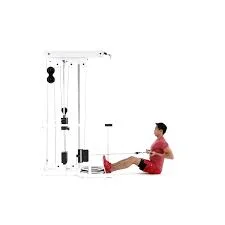
How to conduct: Maintain a hip-width distance between your strides while holding a dumbbell at your sides.
To maintain your core taut, flex forward at the hips and push back on your buttocks. Refrain from moving your shoulders when flexing your legs. Your hip range of motion and hamstring flexibility will determine how much bend you can get.
Look a few inches ahead of your feet to maintain a comfortable neck position.
For a row, you should form properly by raising the weights to your chest. Make sure your elbows are out past your back as you raise the weight to your chest.
Raise your arms to the floor softly as you progressively decrease the weights. One rep is involved. Perform 10 rounds twice a day.
Compared to the regular row, this rowing variant engages your lattisimus dorsi and biceps more.
Alternate bent-over row
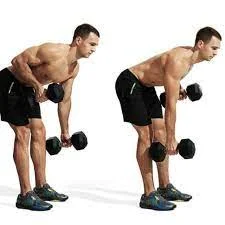
Why it rocks: Compared to other upper-body dumbbell routines, this workout makes use of your body’s strong back, which enables you to lift more weight.
What it does: This exercise targets your mid-to-lower traps, back deltoids, and lats.
How to conduct: Take a dumbbell in each hand and turn it inside out to assist oneself up.
Bend forward with your legs slightly bent, keeping your body at or near floor level. Your abdominal muscles would tighten as you pushed your gluteal area back and lowered your chest.
To start the workout, pull your shoulder blades back, put your elbows behind your torso, and exhale. The correct position is to point your thumb toward your ribcage.
Once your elbows are nearly parallel to your torso, you should begin moving the dumbbells in that direction.
finishing each set with 10 to 15 repetitions.
Barbell hip thrusts

For individuals who believe that squats and deadlifts aren’t giving their glutes enough attention or who just desire a nice, muscular body, the barbell hip thrust is one of the best exercises for building glute mass.
It also improves deadlifts and squats, not replaces them, which is another important advantage. Exercises like deadlifts and squats demand a vertical hip hinge, but this one requires a horizontal one. A targeted exercise program is necessary for general hypertrophy since your gluteal muscles. Your hamstring and gluteal muscles are mostly employed because it’s a hip-hinging movement.
The barbell hip thrust is very good for your glutes since it provides the maximum amount of contraction stress. There’s not a similar exercise. One disadvantage of the barbell hip thrust is that it does not provide much stretching stress. As such, the squat is superior for tension during stretching, even if it is superior for tension during contraction. This makes each of these exercises equally crucial and advantageous for the glutes. This is a helpful cue to fully tighten your glutes when performing back squats.
If you are unable or unable to execute barbell hip thrusts, think about these alternatives.
How to conduct: If you are unable to perform barbell hip thrusts or simply do not want to, think about these alternatives.
Towels or shoulder cushions are optionally placed on the bar for comfort. Once the barbell is exactly over your hip joints, move it back and forth across your thighs. Apply an inner brace. Once your knees and hips are parallel to one another, plant your heels firmly on the ground and utilize your glutes to raise your hips to full extension. return to the floor, but cautiously. That’s one rep.
Instead of tilting upward, your neck should be level with your body.
Push-ups
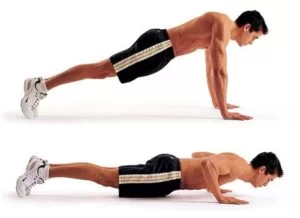
why: the pushup is a popular bodyweight exercise that works much more than simply the chest. According to Sung, anyone can include the workout in their schedule since it is so versatile. Additionally, there are several choices for different emphasis points.
Steps to Take: With your back straight, your wrists curled beneath your shoulders, and your palms flat on the floor, begin the high plank pose.
Think about pressing your hands into the ground. Just beneath you, maintain a neutral neck position.
Make a straight upward strike.
Reps and sets: 3–4 sets of 12–15 repetitions.
AB wheel
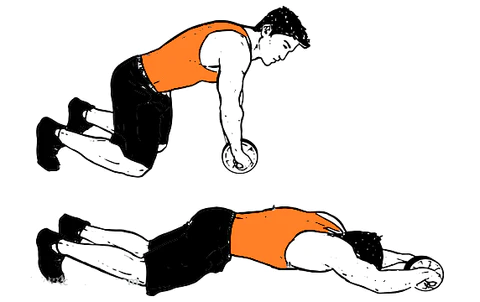
why: This little gadget packs a powerful punch. If you have access to an ab wheel, don’t be afraid to utilize it. This workout targets almost every muscle in your body, including the shoulders, abs, and glutes.
Steps to Take: Begin on your knees, with your palms on the roller.
Move your body as far away from the object as you can without causing strain on your back, much like you would if you were doing a plank. If your hips start to raise or overextend, you’ve gone too far.
Make sure you move precisely and slowly.
Reps: Three to five sets of five repetitions
Kettlebell overhead press reverse lunge
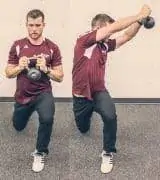
How to conduct: Using your left hand, hold a five to twenty-pound dumbbell or kettlebell at shoulder height.
To execute a reverse lunge, take a step back with your left leg and then stand back up.
Raise the kettlebell above your head while maintaining a small bend in your elbow once you are upright. Retain your arm near your head instead of allowing it to swing widely.
To bring the left arm back to its initial position, lower it. That’s one rep. Do ten repetitions twice a day.
Knee Drive Deadlift
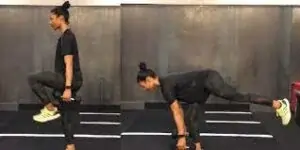
You can do this workout without any weights if you’re a novice. Get a set of dumbbells out for harder workouts.
How to conduct: Hold the dumbbell in both hands and raise it.
By bending at the hips and keeping your spine neutral and your core active, you may push them backward. Do not point your toes; instead, keep your left foot flexed and your left knee pointed downward. As you maintain your hip bend, your back and the bottom of your leg should be parallel to the floor.
Your left foot should still naturally dorsiflex. Maintain a straight posture with a solid core throughout the workout. That is comparable to one repetition.
Hex Bar deadlift
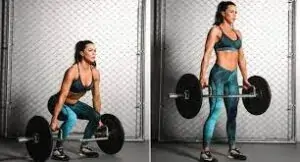
Select the weight that you wish to give the hex bar. If this is your first time doing this exercise, begin with simply the bar and no weight added.
How to conduct: Place yourself in the center of the hex bar with your hips separated from one another.
Maintaining your legs level, raise your hips a little to tighten your hamstrings and back.
To stand tall with your shoulders flat and your back relaxed, press your heels into the ground.
To ensure full hip extension at the end of the practice, engage your glutes. Hold on to the grips as you gently lower the weight to the ground. You should have an open chest and a flat back. This counts as a solo effort. Make eight to ten attempts twice every day.
Bulgarian Split Squat

If you’ve never used this approach previously, simply use your body weight. If you’re more experienced, acquire a 10-pound pair of dumbbells. Straighten your right leg while placing the toes of your left foot on a chair, box, bench, or stairway.
As before, the knee rests precisely above the ankle. Bend your right knee and tighten your left glute while lowering your pelvis as low as possible to the floor or until the front of your thigh is level. with the floor.
That’s one rep.
Slider knee tuck with Push-Up

How to conduct: Start by placing a slider beneath each foot and assuming the plank posture. If you don’t have sliders, you can use a cloth and a hard surface to complete this exercise.
Return to your previous location.
Proceed to do a push-up. With every action, your back should stay neutral as your abdominal muscles contract.
That’s one rep. Make eight or ten attempts twice a day.
Burpee squats press

How to conduct: To begin, stand up and grasp a 10-kilogram dumbbell on either side of your torso. If you notice that this is too heavy and your form is improper, use less weight.
Perform a burpee while lowering yourself while gripping the dumbbells. If you believe this workout is too strenuous on your hands or wrists, you can place dumbbells in front of you. A newbie may do a simple burpee.
Elevate your body off the ground and cautiously raise the dumbbells. Aim for a neutral spine and an active core before pushing yourself off the ground.
Maintaining a tall stance and a clenched stomach, bend your arms, place the dumbbells on or just above your shoulders, and then drop yourself into a squat. Standing, raise both dumbbells above your heads. That amounts to one rep. Twice a day, make eight or ten attempts.
Arnold Press
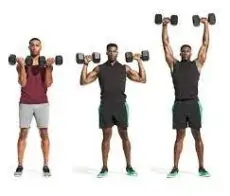
Bend your arms 90 degrees and place dumbbells in front of your face to begin.
Lift the weights straight and extend your arms as far as they will go. You can start afresh by reversing the movement entirely. That’s one rep. Make eight or ten attempts twice a day.
Upright Row and deadlift
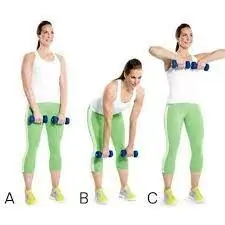
How to conduct: Place your knees hip-width apart and bend them slightly as you stand.
Extend your hips, contract your core, and descend the weights down your shins while keeping your spine neutral.
Rise to your feet gradually. Until you reach the top, raise your arms to your chest while maintaining your elbows out to the sides. That amounts to one rep. Perform 10 rounds twice a day.
Squat, curl, and press

How to conduct: Position your feet directly beneath your hips and grasp a dumbbell in each hand. Squat until your thighs are parallel to the floor to get back into a sitting position, being careful not to allow your knees cross your toes.
Once you have brought the weights to your shoulders, perform a bicep curl after lifting with your heels to stand back up.
Goblet Squat
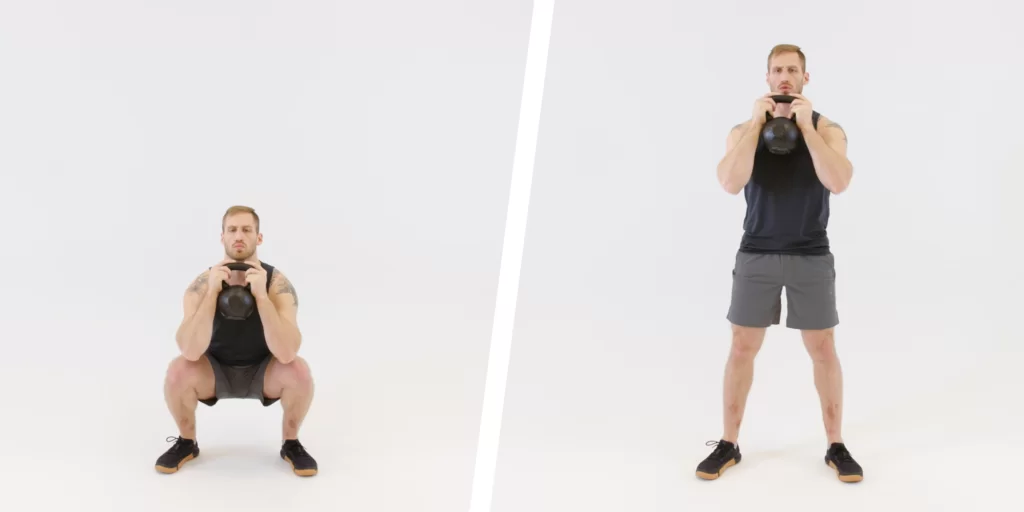
How to conduct: When standing, spread your feet wider than shoulder-width apart and tilt your toes slightly outward. Lower your entire body until your thighs are perpendicular to the floor while maintaining an active core. This asks you to push your hips back and bend your knees.
As you rise to the starting position, ensure that your heels are supporting the proper amount of weight. Do two sets of 10 repetitions to finish one rep. The relevant muscle is that:gluteus medius, gluteus minimus, gluteus maximus, vastus lateralis, vastus medialis, and vastus intermedialis, as well as the rectus femoris.
Reverse lunge with one leg raise
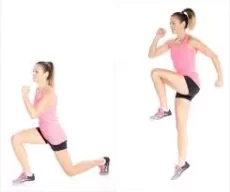
How to conduct: Stand with your feet shoulder-width apart and contract your core.
Reposition your right foot so that the heel touches the sole and leaves the ground.
Lower yourself into a lunge by flexing both knees at a ninety-degree angle. Raise your right arm forward while bending your elbows with your left arm slightly out behind. Maintain an inner curvature of your hips; do not try to extend your buttocks using your related abdominal muscles.
With your left foot, bring your right knee to your chest, then hop as high as you can.
After landing softly in the typical posture on your left foot, move to enable you to execute another lunge. One rep consists of ten executions.
Complete every repeat on a single side. After that, reverse lunge and switch sides to get back to the single-leg hop.
Benefits of compound exercises
Although some unskilled fitness enthusiasts might think that doing isolated exercises is enough to build muscle and strength, this is not a smart approach for every muscle group. The first step in any successful fitness program is to incorporate compound exercises, or routines that enhance foundational activities. This affects even the most skilled weightlifters and sportsmen.
Even if isolation exercises are easier and less strenuous, compound lifting is more suitable for healthy beginners. Compound lifts remain the greatest option, although isolation exercises can be helpful for athletes with a strong foundation in strength and bulk.
Train many muscle groups simultaneously: The essential point is not that training becomes more effective when difficult lifts or compound workouts are performed. Working out many muscle groups simultaneously and using heavier weights might help you gain more muscle mass and improve your overall strength. Gaining muscle bulk and power is substantially easier with most complex activities. Compound lifting is the greatest way to define functional fitness.
Greater Ease in Gradual Overload: Compared to isolation workouts, compound strength exercises enable you to increase the weight much more quickly, so you may notice a faster improvement in your muscles whether you are a rookie or even an expert lifter! Compound lifts have a significantly higher ceiling.
Boost Growth Hormone and Testosterone: Compound lifts produce noticeably higher quantities of these two anabolic hormones than single sessions do. Their ability to grow muscle is further enhanced by that element.
Stronger, Denser Bones: You may strengthen your bones and muscles at the same time by lifting heavier weights. You develop whole-body strength in this way.
Enhances Intermuscular Coordination: In compound workouts, you can teach your muscles and joints to function as a single unit instead of as a robot by employing more advanced lifting techniques. They both produce and control force together. This will greatly improve your movement efficiency, balance, and coordination.
This is particularly helpful if you wish to improve as an athlete. Even if you’re not interested in sports, compound workouts are helpful movements that help you become ready for life in the real world, which is something we all experience.
Increase Calorie Burn: Because compound workouts require a greater range of motion and a larger net energy expenditure than isolated exercises, they burn more calories. The best course of action is to complicated workouts if you value reducing weight. Moreover, having more muscular mass will increase your resting metabolic rate. That is a fat-burning double punch.
Enhances Flexibility and Mobility: A lot of people don’t know that compound lifts are actually a type of dynamic stretching. Stretching and contracting your muscles with each repetition of compound movements that require a wide range of motion can help you increase joint mobility and flexibility. Check your mobility.
Boost Your Muscle and Strength: Because numerous muscle groups work together to accomplish the exercise, you may load complicated motions with more weight than you would when isolating a single muscle. A reliable way to gain strength is to apply the progressive overload principle, which forces your muscles to grow and adapt in response to increased tension. You’ll be able to use larger motions to challenge the muscles more.
Effectiveness: Compound exercises target many muscle groups at once, so you may train your complete body with fewer exercises than an exercise program that just consists of isolation exercises. While the hamstrings and glutes are used to generate hip extension, making a deadlift predominantly a lower-body workout, your back muscles are also critical for load stabilization as you draw from the floor. Your pectoral and triceps muscles cooperate to push the weight over your head during the bench press exercise. Your pecs adduct as your triceps extend your elbows. Additionally, you will burn more calories when you use all of these muscle groups at once. All things considered, you will get more value out of your money with these workouts.
Solidity: Because compound motions require you to use multiple joints simultaneously, stability is essential to good performance. Our smaller stabilizing muscles will contract to keep our joints moving in the desired direction while our bigger muscles generate the force for the movement. Increased neuromuscular coordination and a high degree of stability are almost always required for compound exercises.
Energy: If you’ve ever been weary after completing a set of front squats, don’t confuse this feeling with being out of shape. You will use a lot more energy when executing a set of complex exercises as opposed to individual workouts. Their cardiovascular systems are stronger in them.
Exercises such as lunges, deadlifts, and squats put a great deal of strain on the neural system. The central nervous system will also be strongly activated during complex workouts. When you implement these significant changes, you will experience this type of tiredness, thus you must approach them from a different angle.
Maximal Hypertrophy: By targeting big muscle groups, compound lifts increase total strength and muscle growth.
Saving Time: Complex lifts are a faster way to finish your exercise than isolating particular muscles. They target many muscle groups simultaneously, enabling you to do more.
The common mistakes occur during compound exercises
Compound Exercises Cannot Be Done in One Size That Fits All
Not every advanced exercise is appropriate for everyone. Despite being one of the most popular exercises in programming, the barbell back squat might not be a suitable fit for your body type and level of experience. You could not benefit from common workouts if you have restricted movement, an anatomy that makes some motions difficult, or a history of injuries. Fortunately, there are alternative ways to get your complex lifts in, including moving the weights or rearranging the equipment.
Don’t Go Overboard
If someone is new to strength training, it may take some time for them to establish a baseline for how an exercise should feel. This is because inexperienced lifters lack the muscle endurance and stability necessary to maintain a proper form throughout a lift.
Correctly adjust the weight, sets, and repetitions. You may be used to watching fitness enthusiasts and sportsmen do maximum barbell squats and deadlifts, even when they are not required to.
Many eventually had terrible first failures. They also don’t have the patience or understanding of how draining failing may be. While it’s acceptable to give yourself a quick rep at first, you should make the most of each rep to build that foundation over time.
Don’t Underperform
Beyond just not lifting large weights, a typical error made by many is not pushing oneself on more challenging compound exercises. There are various ways to increase the difficulty of compound exercises without adding additional plates, such as by slowing down the eccentric part of a workout or adding pause reps. These workouts will help you build muscle and strength since they will prevent you from performing the same sets and repetitions with the same weight.
Safety
If you have any issues regarding the proper technique for doing a complex exercise, speak with a physiotherapist or other fitness professional at your club. They can illustrate the appropriate way to avoid getting hurt. For the fitness routine, they can provide a safe workout schedule. Compound exercises, like deadlifts, require certain techniques to keep you safe and avoid injury.
Work with a trainer or fitness specialist before performing these exercises, particularly if you haven’t done the move previously. They can observe you to make sure you’re taking the right strategy. You may eventually be able to safely complete the tasks on your own. Still, working out with a partner who can see you is a wonderful idea.
If you’re new, consult a trainer or other fitness specialist at your gym. They can help you figure out what the right beginning weights should be. Starting with a lightweight that you can comfortably perform 10 to 15 repetitions within a set is a decent general rule of thumb.
Increase the weight for the second and third sets if it seems steady and comfortable for you. You should feel burned out during the last few repetitions, but you should never waver. In between sets, stop the workout and sip some water if you feel lightheaded, exhausted, or ill.
Conclusion
Compound exercises are a great method to get the most out of your gym sessions. Try to vary your routine and include some new complex workouts every few weeks.
Because of the diversity, you’ll be able to engage more muscle groups and prevent frustration and plateauing. Ask a trainer or other fitness specialist at your club if you have any questions about how to do a complex exercise correctly. They can illustrate the appropriate way to avoid getting hurt.
See your doctor before starting a new exercise regimen; they should provide a safe program plan for your level of fitness.
Your program’s core consists of compound lift exercises. These workouts will correctly train and overexert your major muscle groups. Your overall strength and size increase come from them. The more isolated exercises are meant to help you target specific muscles or portions of muscles that need more attention. They are there to help you with your overall look, inconsistent strength, and weak muscles.
FAQs
Why Use Compound Exercises?
If you want to improve your overall strength and have a productive workout, an exercise regimen that mostly consists of compound motions might help you achieve the required outcomes. If your aims or requirements are more specific, separation is often more suitable. A very effective strategy can involve combining isolation exercises to target different muscle groups as the top layer of training and complex motions as the basis.
What is a compound workout?
Many muscle groups cooperate to execute a movement in a complex exercise, such as the dumbbell shoulder press exercise. This exercise simultaneously works the pectoralis major, deltoids, abdominals, and triceps brachii. Compound exercises and isolated exercises are not interchangeable. These focus on a single muscle group at a time.
Which five compound workouts are the golden ones?
The five movements that make up the Big 5 of strength training are the pull-up, shoulder press, squat, bench press, and deadlift.
Can we perform complex workouts every day?
If you’re a healthy adult, you should be able to conduct strenuous workouts two or three times per week. Focus on distinct muscle groups every day. Between strength training sessions, give your muscles at least 48 hours to heal.
Should Someone perform every compound workout?
If you want a full, productive, and practical workout, devote the majority of your training time to compound exercises. However, there are situations in which it is both required and advised to isolate a particular muscle, muscle group, or joint.
Does one lift per day be sufficient?
This program might be somewhat boring at times because of the lack of diversity and variation in the exercises, but it works wonders for gaining muscle. Powerlifters might also gain by performing one exercise every day because their main goal is to be the strongest in the three major lifts: the deadlift, bench press, and squat.
References:
- Mandaliya, D. (2023, December 13). Compound Exercises – The Best Way to Build Muscle and Burn Fat. Mobile Physiotherapy Clinic. https://mobilephysiotherapyclinic.in/compound-exercises/
- Chertoff, J. (2019, November 13). How to Add Compound Exercises to Your Workout Routine. Healthline. https://www.healthline.com/health/fitness-exercise/compound-exercises
- Icohen, & Broser, E. (2020b, August 25). The 10 Best Compound Exercises for Strength. Muscle & Fitness. https://www.muscleandfitness.com/workouts/full-body-exercises/top-10-compound-lifts-maximum-size-and-strength/

